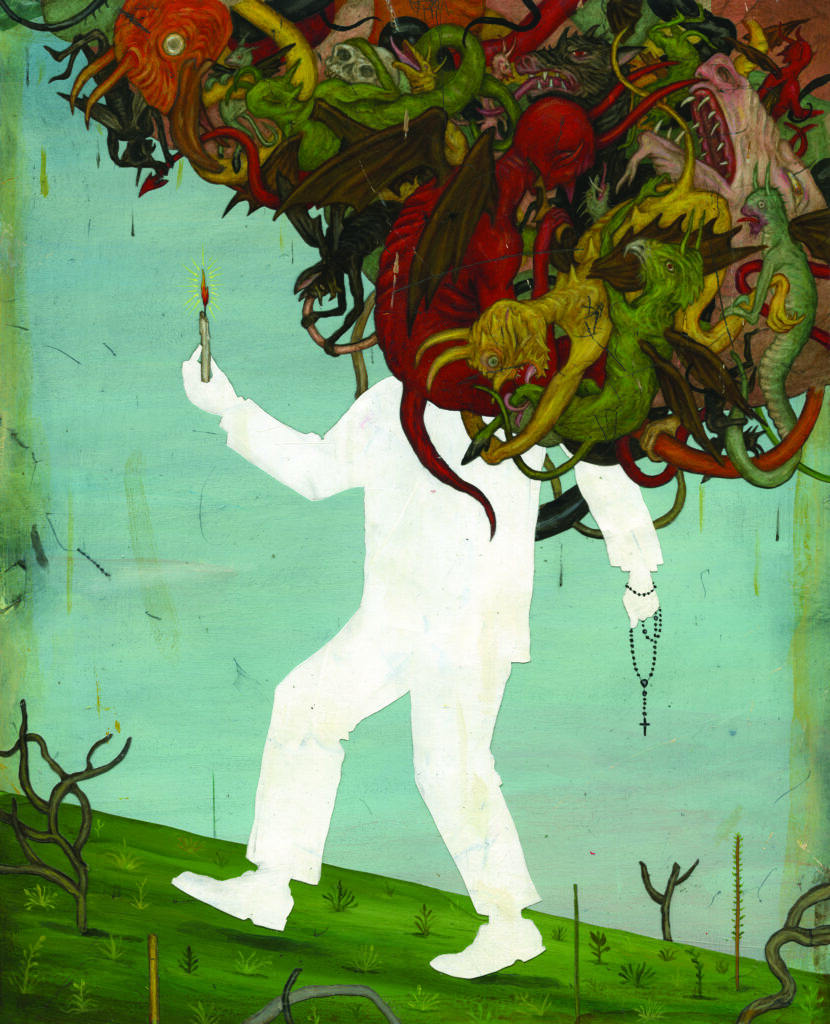
When I was 14 years old, I accompanied my father on a trip to the East Coast that included a weekend at a house owned by the Marymount sisters, of whom my aunt, Ellen Marie Keane, R.S.H.M., was a member. Bunking out on a couch in the living room one night, I found myself unable to sleep. I perused the nearby bookshelves and discovered something intriguing: a 1971 novel by William Peter Blatty, “The Exorcist,” later made into a famous movie. I settled down by the light of a lamp to read it … and didn’t sleep for the rest of the night. Or week.
“The Exorcist” was terrifying in a way that most horror novels — like Stephen King’s “It” or Dean Koontz’s “Midnight,” both of which also scared the bejesus out of me as a teen — were not, especially for a Catholic. Other novels conjured up demons and frights that even a teenager knew were not real, were literally phantasms. But “The Exorcist” dealt with a kind of demonic possession that the Catholic Church teaches is very, very real.
To be clear, the Church does not leap rashly to the conclusion that a person is possessed if he or she begins to manifest out-of-the-ordinary behaviors, and it always calls for a thorough examination that includes medical, psychological, and psychiatric testing before bringing in an exorcist. Nevertheless, every diocese in the world is expected to have an official exorcist (albeit usually kept secret), and there are certainly times when the Church feels scientific analysis or treatment has been confounded, and a priest is called in to perform specific rituals in order to cleanse someone of demonic possession.
The Catechism of the Catholic Church is clear in its assertion that possession and exorcism are both indeed factual things, but not all Catholics agree. Ignatian spirituality has a strong focus on avoiding the temptations of the “evil spirit,” and yet Arturo Sosa, S.J., the superior general of the Jesuits, said in 2017 that he considered the devil to be more a symbolic figure we use to express the reality of evil than an actual person. His fellow Jesuit Pope Francis demurred, writing a year later that “we should not think of the devil as a myth, a representation, a symbol, a figure of speech or an idea. This mistake would lead us to let down our guard to grow careless and end up more vulnerable.”
“While the demons in [‘The Pope’s Exorcist’] may seem extreme and exaggerated, the movements of disturbance and evil inside of us have the power to overtake us, which is a very real struggle I think for anyone, believer or not.”
—Edward J. Siebert, S.J.
Catholic theology has traditionally relied on four main sources for its structure and development — Scripture, tradition, reason and experience — and it is true that three of the four suggest that demons are real and active. Scriptural accounts of possession, temptation, and exorcism abound, including in all three synoptic gospels; the same stories have parallels throughout the history of the church; even human experience across the globe offers evidence for possession (Christians don’t have a monopoly on demons, remember). Of those four sources of input, only reason says hold it with the pea soup and the Vin Diesel voices, it’s all just superstition.
Edward J. Siebert, S.J., the rector of the LMU Jesuit Community and the founder and president of Loyola Productions, served as executive producer for “The Pope’s Exorcist,” a movie about Father Gabriele Amorth, an Italian priest who said he had performed 160,000 exorcisms during his lifetime. The film, starring Russell Crowe, was released in the United States this past April. It is historical fiction with a horror motif, not an in-depth look at exorcism in the Catholic Church.
“Stories of good and evil are as old as time, and films like ‘The Pope’s Exorcist’ reflect on some of the most challenging aspects of our faith,” he told me over email. “While the demons in this film may seem extreme and exaggerated, the movements of disturbance and evil inside of us have the power to overtake us, which is a very real struggle I think for anyone, believer or not.”
So what’s it all about, then? Are exorcisms real, or just another clown that lives in the sewers? Even as something of a skeptic on the matter, I think it’s fair to ask oneself a question: If you’re willing to pray to saints and believe in their intercession, how is that different from fearing demons and theirs?
At the same time, I do find myself simpatico with Pope Francis when he writes the following in Gaudete et Exsultate:
“The devil does not need to possess us. He poisons us with the venom of hatred, desolation, envy and vice. When we let down our guard, he takes advantage of it to destroy our lives, our families and our communities.”
In other words, I’m probably not in that much danger of being possessed. I’m definitely at risk for letting the devil into my life.
James T. Keane ’96 is senior editor of America magazine. Keane’s writing has appeared in Philadelphia Weekly, U.S. Catholic, Busted Halo and elsewhere. His “To Forgive or Not” appeared in the fall 2022 (Vol. 11, No. 1) edition of LMU Magazine. Follow him @JamesTKeane.
